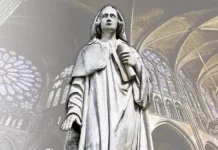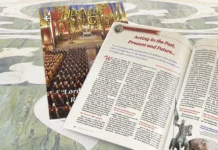Present landscapes must be updated by creating “aesthetically consecrated” works in harmony with the exuberant panorama God has granted to our beloved Brazil.
If beauty is what pleases the eye, as St. Thomas Aquinas says,1 we can say that Brazil has been graced with an immense treasure of natural wonders.
In fact, Brazilian territory is home to unparalleled riches. Under the symbolic aegis of the Southern Cross, there are forests, grasslands and hinterlands, plains and highlands, surrounded by vast coastlines dotted with paradisiacal islands. They are home to a variety of fauna and flora, in an almost infinite display of colours…
For good reason, many Portuguese at the time of discovery thought they had found Eden, such was the fascination that the New World elicited in them: “If terrestrial Paradise is somewhere on Earth, I do not think it is far from those regions,”2 wrote the Italian navigator Amerigo Vespucci in 1502.
To these wonders of nature, however, is added human art. This, when united harmoniously to a panorama, seems to impart something religious and sacred to it, because the beauty of a masterwork reflects not only the wisdom and ingenuity of the artist, but also his faith.
The lesson of Venice

in foreground and Santa Maria della Salute Basilica in background
In this regard, the recently deceased philosopher, Roger Scruton, comments on Venice: “Who can doubt, on visiting Venice, that this abundant flower of aesthetic endeavour was rooted in faith and watered by penitential tears? Surely, if we want to build settlements today we should heed the lesson of Venice. We should begin always with an act of consecration, since we thereby put down the real roots of a community.”3
Yes, the art of the proverbial Italian city, not only in the Basilica of St. Mark – “shining with a light that is not of this world,”4 the British philosopher will go on to say – but in all its fullness, manifests something divine, transcendental and sublime, which transports us to supra-worldly realities. To be enchanted by the floating city, known as “La Serenissima,” it is enough not to have an insensitive heart, like that of Countess Anne de Noailles who, after arriving on one of its shores, exclaimed with a scornful air: “Trop de beauté! – Too much beauty!”
In truth, that French lady was deeply mistaken, because one of the fundamental characteristics of beauty is proportion: there is no exaggeration in it. United to splendour, the beautiful enchants us and inspires us, in order to finally console and elevate us to the highest peaks.
The example of Brazil
In the last five centuries there has been no shortage in our country of what we might call, following Scruton’s terminology, “acts of aesthetic consecration.”

The first Mass on Brazilian soil – and the first official act of the nation – was adorned, it is true, with a crude and rough cross, but in compensation was celebrated on a “very well arranged altar,”5 as Vaz de Caminha attests, which harmonized with the liturgical chants interspersed with the sounds of native birds and the restful murmurs of the sea.

Later, missionary zeal built cathedrals like that of Olinda, in Pernambuco, framed by the turquoise blue of the ocean and flourishing palm trees. The Church of St. Francis of Assisi in Ouro Preto, Minas Gerais, nestled between valleys and mountains, consecrates the work of Aleijadinho in a cosy and placid atmosphere, whose faith exhales an almost mystical balm. Finally, we could not omit Christ the Redeemer in Rio de Janeiro, an archetypal monument of devotion, with His arms open to welcome the pilgrims and, at the same time, to exalt the magnificent scenery that frames Him.
Returning to the idea of the English thinker, we might ask ourselves: how to construct today, with an eye to harmonizing beauty and faith?
Looking to the past…
To better respond, we should look to the past.
When the brave monks of old erected a monastery on a mountaintop, facing all the difficulties that this entailed, they sought to be “closer” to God in every way. Blood, sweat and tears watered the soil of those religious buildings, to enable the marriage between beauty and faith. It was worth the effort, for proximity with the supernatural makes any sacrifice seem small.

These medieval religious were implicitly guided by the principle later articulated by Winston Churchill: “We shape our buildings; thereafter they shape us.” And they applied it with a transcendent and perennial vision. Their buildings were destined to attract and form the hearts not only of their own generation, but also of those to come. And it was not in vain. Still today, abbeys like Mont Saint-Michel in France attract millions of visitors a year.
Contrary to what the “disposable” mentality so in vogue in our days preaches, a religious building must be the prototype of beauty, for only beauty is perennial, as God himself is eternal. The ugly, in turn, is transitory and, therefore, useless. If a building is visually jarring, it also generates unease and, therefore, no one will want to live in it, precisely because it would “deform” the soul.
…so as to build the present
And what about today? Is it still possible to unite, in Brazil, architecture imbued with faith and adorned by a beautiful setting?
Those who passes through the Serra da Cantareira, north of the capital of São Paulo, find their attention drawn to Our Lady of the Rosary Basilica, of the Heralds of the Gospel. It is certainly steeped in the classical sources of religious art, although with striking original features. Framed by the Atlantic Forest, the sacred edifice unites the marvellous with solemnity and devotion. For its part, Lumen Maris House in Ubatuba, also of the Heralds of the Gospel, burgeons intrepidly from a hilltop, bordered by some of the most enchanting landscapes of the Brazilian coastline.

Now, these are two contemporary examples of how beauty and faith are not obsolete. The historical and natural heritage must be preserved, but it is necessary to update the present landscapes by creating “aesthetically consecrated” works, in harmony with the exuberant panorama God has granted to our beloved Brazil.
Faith for Brazilians does not require proof. It is proclaimed by nature and by the buildings that have been erected for its sake. ◊







